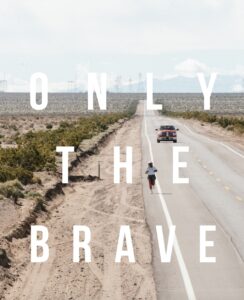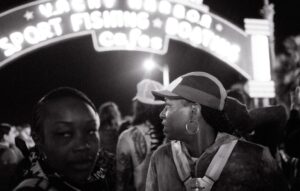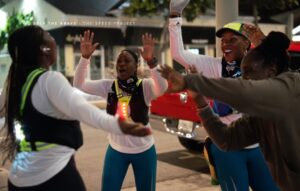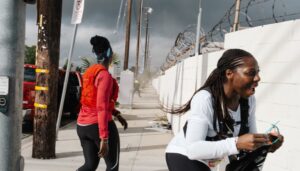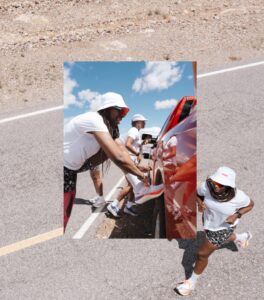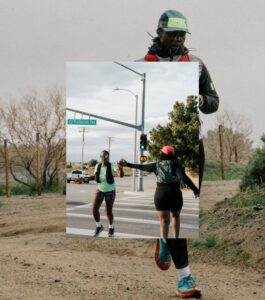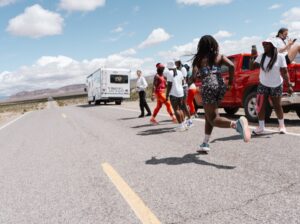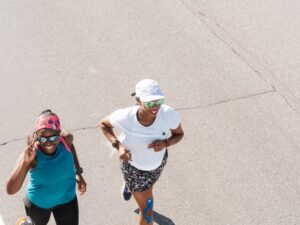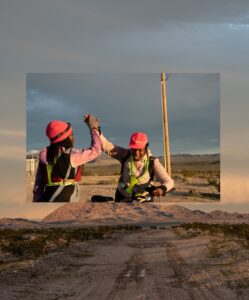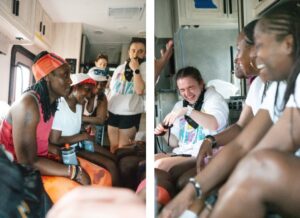This piece was featured in issue #41 of Like the Wind Magazine. Words by Imogen Lees – Photography by Emma Hampson-Jones.
You’ve got to have some nerve to take on The Speed Project, the legendary 340-mile Los Angeles-Las Vegas relay. You’ve got to have even more nerve putting yourselves out there as a group of older Black women in what can often seem like the white-thirtysomething-male-dominated world of ultra running. But what takes the most courage of all is realising when it’s time to quit.
The Speed Project never fails to deliver iconic imagery. The neon-lit start line on Santa Monica Pier. The Welcome to Las Vegas sign. Runners carving a path through the desert landscape: yellow-orange sand and dirt; bright blue, sunshine- drenched skies; a line of pylons in the background; athletes giving it their all.
“The sun was out,” remembers Gloria Sarpong. “It was a lovely day after it had been pissing it down with rain and cold. This was the first opportunity for the whole team to run together after being in ‘pods’ of three. It felt really good. We were running short, quick legs and everyone felt like they were giving it their all. We probably all felt a bit invincible at that time. I know I definitely did. We were in Death Valley – these are the pictures we’d been waiting for. Because up until that point, everything else is not the pictures that you see. Everything else is chaos. It’s dark. It’s wild dogs. It’s the middle of nowhere. It’s blocked toilets in the RV.”
But despite the good vibes the day was bringing, Gloria, crew captain of LDN Sole Sisters, knew she and her right- hand woman Trina Dawkins had a tough decision to make. The journey up to that point had not been easy. Navigation, weather and fatigue had all taken their toll on the team’s speed and confidence. That morning, MK (LDN Sole Sisters’ lead RV driver) had taken Gloria to one side: the numbers were not looking good. If the team maintained their pace, they wouldn’t reach Las Vegas until 4.30am – long after the race would have ended and the celebrations finished. Gloria suggested to MK that the team should run on until midday to see what sort of distance they could cover and whether they could make up any pace, giving them a clearer indication of whether they would reach Vegas in time.
As midday rolled around, Gloria’s thoughts turned to the two nights the team had already spent on the road and the energy they would have to find to continue running and driving for another night. “People were struggling, not wanting to run on their own. People were tired. They couldn’t run in the dark again. The crew were shattered. No one slept properly. The sleep schedule? We might as well have just used it to keep warm.”
Safety was uppermost in Gloria’s mind, for both runners and crew. “The paramount KPI for me is that everybody came home uninjured. Yes, finish the race, but that is actually second to everybody coming home in one piece. So for me, that was the most important thing. I felt very responsible for that. It was a hard decision, but I just knew it was not a wise thing to have everyone out there for another night. I was gutted. But if I had to go back and do it again, it’d be the same decision.”
After 232 miles, LDN Sole Sisters got into their support vehicles and drove for two-and-a-half hours until they were just outside Las Vegas, where they ran the final few miles to the finish.
Looking at social media and brand campaigns, you could perhaps be forgiven for thinking that most runners are young, blonde white women or gritty middle-aged white blokes. Yes, of course there are exceptions to that broad-brush conjecture, but it remains the case that many groups feel underrepresented in running culture. Take Black women aged over 40, for example, which is why Gloria Sarpong and Trina Dawkins created the LDN Sole Sisters project as a space for Black women aged 40+ to run together… and to take on The Speed Project.
“Becoming a middle-aged woman, mid-life woman, whatever you want to call it, is not something I’ve never been afraid of. I don’t ever remember my mum going: ‘Oh my God, I’m getting old.’ I’ve always welcomed it,” says Gloria. “But that is not the case amongst a lot of people. What’s the problem? Do you not want to have longevity? What are you supposed to do – die at 30?
“I feel like you really get your superpowers in middle age. Obviously that ties in with my love of running. Sometimes, I’m running with 25-year-olds, and they’re fantastic – particularly when it’s young women. But I want to see strong, older women. I want to see people that look like me. I want to see people who understand the hot flashes and the reduced bone density and the perimenopause and menopause. And I want to empower those people.”
Gloria is a massive advocate for exercising as a way of mitigating some of the symptoms of menopause, because of how it has helped her, particularly around brain fog. Trina also sees huge value in exercising with similarly aged women, for both mental and physical reasons. “Being in a space with women of similar ages and older, the conversation is different,” Trina says. “You can’t have those conversations about perimenopause, hot flashes and all that stuff with the younger generation.”
Trina adds: “When you’re walking or running with women in that same category, it’s an opportunity to talk rather than just going on the internet or listening to your GP. You can ask questions, and feel in a safe space doing that as well. I think that’s really important, creating that avenue for people.”
But visibility and inclusivity are just as important as creating a supportive space. Getting LDN Sole Sisters to The Speed Project was a way of showing the world that older Black female runners can take on challenges and put themselves at the centre of running adventures. Ultra runner and blogger Trina explains: “I do things that I don’t see other people do. We all want to do things that we see other people doing because they inspire and encourage and motivate you, but sometimes I put myself in spaces because I want to try something new. When we got to the [TSP] start line, and we were speaking to people, we were received so well. And it was just something that you could never, ever have imagined.
“So we’re just hoping this is a starting point,” she adds. “We’re just hoping to take other women on adventures like this so they can see that you can go out there and try new things. Going out there and taking that first step is the most important step.”
Ah, the TSP start line. Everyone who was glued to Insta for the 2024 event will have had a glimpse of the bright lights, the electric atmosphere and social media host Jarick Walker’s infectious energy, but what does it actually feel like to be on Santa Monica Pier before the sun comes up?
“It is crazy,” says Gloria. “There are hundreds of people on Santa Monica Pier waiting for this race to start. It’s just buzzing. This year, one of the women that we know, who has done [TSP] several times, really wanted the all-female teams to take up space by starting together and pushing to the front. So it was really nice that the whole team got to start the race together.”
“Actually,” she adds, “we got so carried away, we forgot our navigation. We went in completely the wrong direction. We got maybe 200 yards down the road and said: ‘Guys, what are we doing? Where are we going?’ Navigation was not the team’s strong point, by the way.
“You’re heading through LA, in the middle of the night. Looking back, that was probably one of my favourite parts of it. It wasn’t scary because you’re in the middle of the city, there were loads of people… it was like a big game of tag, because every now and again, you would look up and you would see another team running down another street or going a different way.”
“I felt like I was at a rave,” says Trina. “Honestly. It was just jam-packed with people, just happy. The vibes were just lit.”
Gloria also experienced a more inclusive atmosphere than at other start lines. “The organisers just want you to have a good time. They just want you to succeed. And I think that that was the thing. You know, it’s called The Speed Project and, having attempted it, speed is a huge element. Not to be underestimated.
“And usually within those speedy spaces,” she laughs, “there can be a few tossers, but there is none of that. At least, I didn’t experience that. I think because you’re all there with your teams, you’re vibing off everybody’s energy as opposed to being at the start on your own and being stressed.”
Teams attempting The Speed Project work out their own route between Los Angeles and Las Vegas, and that includes running at night. As a female-only group, how did LDN Sole Sisters take personal safety into account?
“We had the support vehicle and the crew trailing us in certain areas,” Trina explains, “and we had access to safety equipment, like pepper spray and stuff like that. But you know what? There was not once where I didn’t feel safe.”
“Trina is a different kind of person,” laughs Gloria. “She took legs that were dark and in the middle of nowhere on her own. She was completely unfazed by it. That is not the same for the rest of the team! My fear came and went, but I didn’t feel alone.”
Trina and Gloria took on one of the night-time legs together. “It was very dark,” Trina remembers. “Even with light-up vests, head torches and handheld torches, you could still only see a couple of yards in front of you. But there were two of us. So you always feel safe anyway. But I love night running. So actually, being outside running in the dark and doing it with somebody else is even better.” They experienced the sunrise together, although Trina admits: “My phone could not do it justice.”
As crew captain, Gloria had the safety – and the happiness and mental health – of the whole team on her mind and explains how she approached the night-time legs of the race. “If you feel empowered running on your own, by all means, please do that,” she says. “If you’re too nervous to do it at any point, someone will run with you or cycle with you. If you don’t want to, don’t do it. It’s not a thing that I would have ever forced anybody to do. If someone says: ‘I’m not going to do that,’ all you can say is: ‘Don’t worry, you’re doing a really great thing. A really brave thing.’”
Running through remote rural areas, it’s not a surprise that many landowners keep dogs to guard their property. “I love dogs,” Gloria explains. “I’m not scared of them. And lots of them are just behind a fence, protecting their boundary.”
But then there were the three dogs that were not behind a fence. “When they came charging down the road towards me,” Gloria laughs, “I stopped running immediately, because that’s exactly what you have to do. You can’t keep running because they think it’s a game or that you’re prey.” So Gloria stopped and roared at them. “The lead dog, which really did not like me, just carried on barking. And then I just did it again. It looked at its companions, as if to say: ‘I don’t know what this two-legged thing is with lights on roaring at me in the middle of night, but I don’t want any part of this.’ I walked further along and then carried on running.”
However, Gloria could not carry on running all the way to Vegas. After 232 miles, and with the prospect of not arriving in Vegas until around 4.30am if they continued running, Gloria focused on the safety of the team and the crew. “I really did want to give the team a chance,” she says. “Part of me was going: ‘Surely not 4.30 in the morning? OK, so we’re going to miss the pool party, but we’ll get there for something. Surely not 4.30? But the numbers don’t lie.”
Gloria gathered the team and crew together and explained the situation and what it might mean in terms of safety and exhaustion to complete the remaining 108 miles. “It was a little bit like letting the air out of the balloon,” Gloria recalls.
“It was mixed emotions,” Trina remembers, “because obviously, everyone’s goal is to actually finish and complete a run all the way to Vegas. But I think when Gloria delivered the numbers, what we’d achieved so far, and what we still had left to go, and possibly the time we could arrive in the morning, everyone just thought: ‘Yeah, we’ve done a good job.’ And it was safety reasons, as well.”
“I think everyone was a bit in shock,” Gloria recalls. “When I look back on it, I think even though I know that the numbers wouldn’t have changed, we would have just got slower, if people [had asked to carry on], I think there would have been a small part of me that would have gone: ‘OK, let’s do another hour.’” But Gloria realised at the time that she was only putting off making a tough decision.
As they drove through Nevada, “it started to hit me,” she says. “I was devastated, obviously, because the plan is always to finish the race, isn’t it? And I think there’s definitely no shame in not finishing the race, but it’s the first time I’ve never completed a race.”
Going from running together in the sunshine to driving across America in the back of an RV was a huge emotional jolt, and there was a lot to process. Gloria admits that she believed she could have run more, and that Trina and some members of the team felt the same way. But other people in the team would not have been able to sustain another night – for some, running in the dark and the open desert had been a stressful experience. “That’s fine. That’s not a criticism of anybody,” Gloria says. “In the daylight, everything looks great again, but I don’t think we’d have had six people to run throughout the night.”
The final element of TSP is a pool party where the teams gather. In the RV on the road through Nevada, Gloria deliberated over whether to tell TSP they had pulled the plug. But then she decided to let the 700-strong WhatsApp group of competitors and organisers know what was going on and that they would be at the pool.
“The messages that we got back, and the love and outpouring that we received from the other teams in terms of what we’d achieved – honestly, that really elevated my mood,” Gloria explains. “We were being celebrated by these incredible athletes. People that had finished said: ‘We’ll be waiting for you at the pool party. You’ve done brilliantly. You should be proud of yourselves.’ I cherish that because we were talking to people that [had run TSP] in 30 to 40 hours. They were saying to us that we are incredible.”
The plan was that they would run the final 10 miles into Las Vegas, but that didn’t quite happen. “I think we did 5km in the end,” Gloria remembers. “We ran to the Vegas sign, which lifted spirits a bit. There was another team who gave us an epic welcome. They had shots, and they were partying and taking pictures of the sign.”
All the other teams had had the chance to get changed; however, LDN Sole Sisters turned up at the pool party in their running gear. “But it was great,” Gloria says. “I was starting to crash a little bit with my emotions, but meeting people that we’d been communicating with for months was brilliant. I thought, this is like spring break.”
If LDN Sole Sisters had pushed on to the finish, it would have impacted their visibility at TSP. As a team of older Black women, it was important to be present at the pool party and be visible among the younger competitors. “Look at us, we’ve shown up,” Gloria laughs. “You’re lovely, I’m old enough to be your mum, maybe your nan! But it was very important: we had an all-Black female team in the space with all these great youngsters. We were definitely among the oldest. It meant something to be at that pool party and I think to minimise it, to think that it’s just [partying], you’ve not understood the mission at all.
“When I was trying to hold back tears, receiving my medal from the organiser, he said: ‘You don’t understand the impact you’ve had.’ I was gobsmacked because I know, but you know, as well. You are a white man who puts on this incredible race, [who] has a level of privilege… and you’ve recognised why we’ve done this.”
Gloria and Trina plan to return to TSP in 2025. “It means so much to me,” explains Gloria. “I’ve cried. Am I going to cry again? It’s just emotional, because I’ve wanted to do [TSP] for so long. It’s hard to feel like you’ve achieved something fantastic, but also it wasn’t, because we didn’t complete it. Deep down it was fantastic. I’m really proud of everyone for taking up the challenge because we’re not your regular ‘ultra ultra marathon’ people. We’re not your regular ‘Oh, look at us going to do an unsanctioned race.’ We’re regular women, with so many things going on in our personal lives. It’s a really hard emotion to be devastated, but also ecstatic at the same time.”
This is definitely not the end of the story. Gloria says: “I feel like we’ve achieved our goal. We wanted Black women between 40 and 50 to take part in the hardest relay race out there. We gave it all we [had]. But obviously, the personal goal for me is that I’ve got to finish it, and that’s fuelling me for next year, and I know it is for Trina.”
“There were waves of emotions,” Trina says. “From the time when Gloria called us all together and said this is what we’ve achieved so far, this is where we might get to and how long it’s going to take us, and then we called it. And then the drive before Vegas, and just thinking about that long, endless road with no footpaths, just bend after bend after bend – [we] would have had to run that in the dark.
“When we got [to the Vegas sign]”, Trina adds, “the celebration was just out of this world, even though we told the other teams that obviously we’d had to stop. We pulled the plug. So we didn’t finish it – it didn’t matter at all. [We] still achieved something amazing. We were just up there. it was the best feeling in the world. It felt like we’d run the 340 miles. It was really good to be celebrated by so many people, [who were] just so welcoming. Yeah, it was amazing.”
Imogen Lees has worked on Like the Wind for a decade, during which time her running has slowed and her wrinkles have flourished. IG @looksbetterinsequins
Emma Hampson-Jones is a creative director and photographer working in lifestyle and sports, with the aim of capturing the emotion in that moment in time. IG: @health_club www.emmahampsonjones.com


